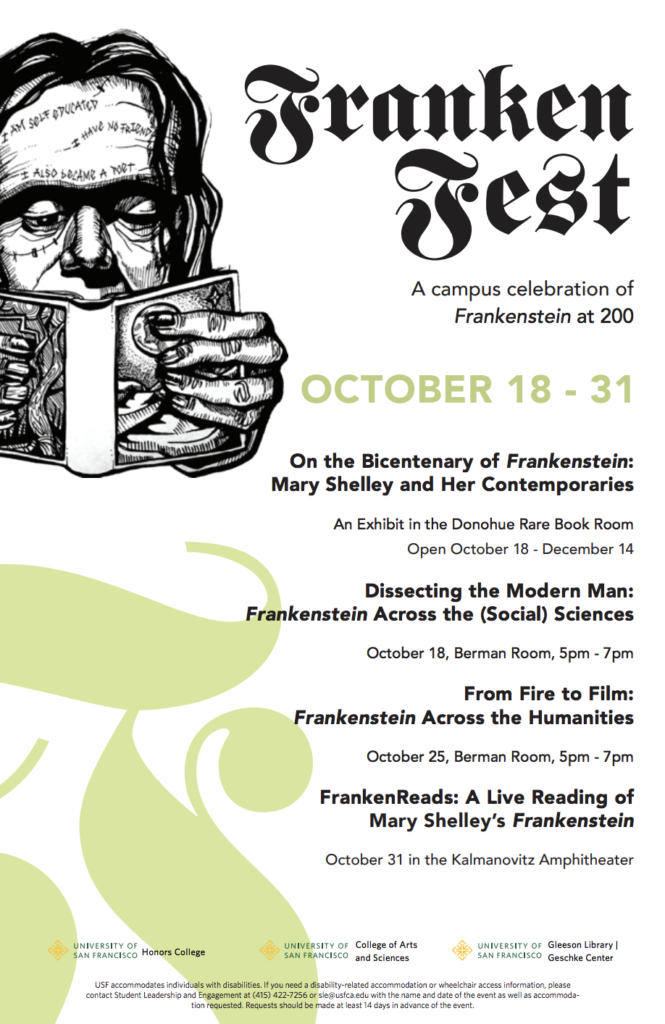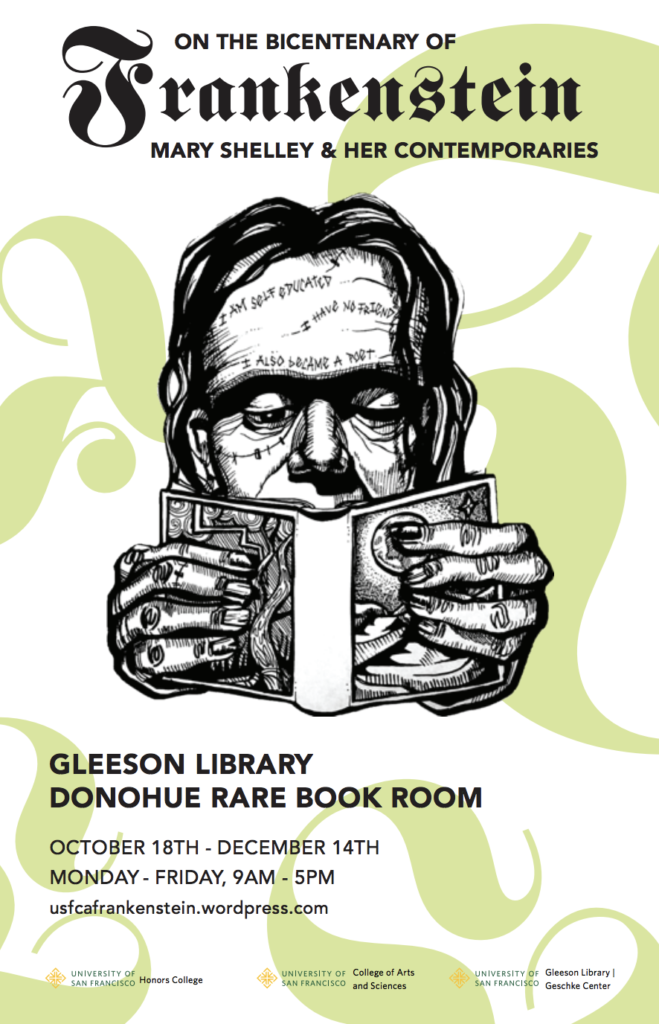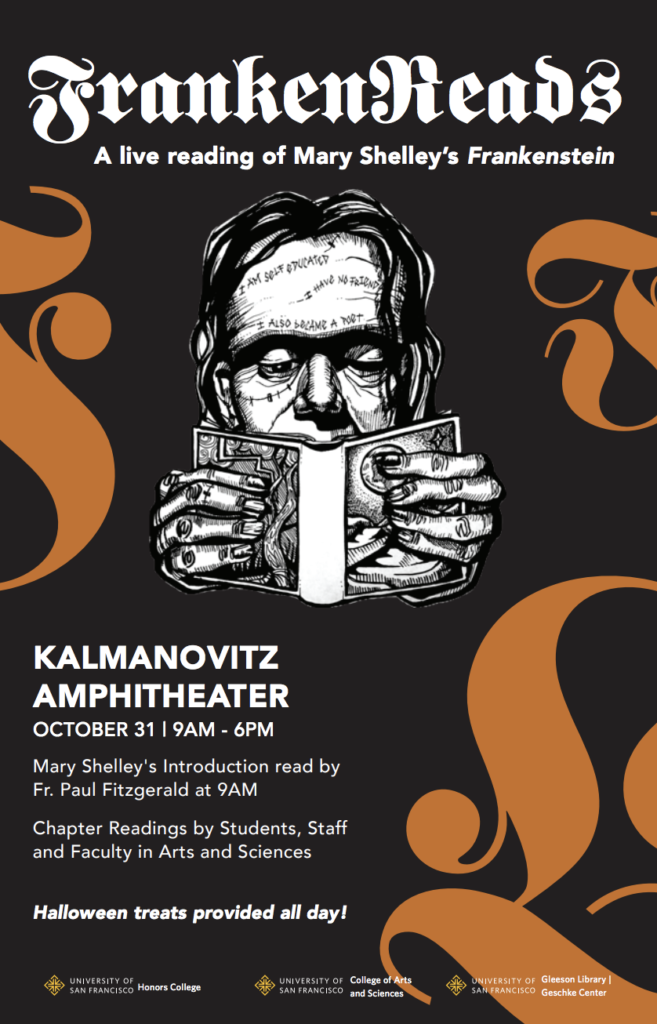Frankenreads Q & A, University of San Francisco
We continue the Frankenreads Q & A series today by presenting an interview with Omar F. Miranda, Assistant Professor of English, one of the organizers of Frankenreads at the University of San Francisco. Events at USF will kick off on October 18th, with an exhibit in the Donahue Rare Book Library, and continue with interdisciplinary panel discussions October 18th & 25th, and conclude on Halloween with a live reading of the novel. What made you want to participate in Frankenreads, and what do you think is the relevance of Mary Shelley's iconic novel today?When I first heard about the idea for Frankenreads from Neil Fraistat – which was fittingly back in 2016 when we were celebrating the bicentennial of the 1816 Geneva Summer at the NYPL (the year that Mary Shelley conceived the idea for Frankenstein) – I did not expect at the time that it would turn into a world-wide event with more than 500 participating institutions across several countries and continents.This extraordinary outcome speaks as much to the hard work of Neil and his team as the far-reaching appeal of a story about a mad scientist who brings his creature to life. Whether one believes erroneously that it refers to the name of the monster or not, Frankenstein has fascinated readers and audiences for 200 years. In fact, most people today recognize the names of Mary Shelley (and Jane Austen) much more easily than other notable writers of the period such as William Wordsworth, Samuel Taylor Coleridge, Lord Byron, and Walter Scott. The Romantic women are significantly more famous than the men – and that’s a good thing!Frankenstein’s themes of prejudice, loss, exile, ambition, and narcissism (among several others) are still relevant because the novel is in many ways a treatment of human manners. Its portrayal of Victor as an archetypal Faustian “overreacher” who conducts such an unusual, socially-altering experiment presents the kind of ethical dilemmas that we face today regarding our own scientific advancements; we already have -- and will continue to – cede(d) so much in the domain of human activity to artificial intelligence. Frankenreads will, therefore, be a memorable, symbolic, and once-in-a-lifetime opportunity to celebrate Mary Shelley's remarkable achievement by coming together in its honor as a global community.
What made you want to participate in Frankenreads, and what do you think is the relevance of Mary Shelley's iconic novel today?When I first heard about the idea for Frankenreads from Neil Fraistat – which was fittingly back in 2016 when we were celebrating the bicentennial of the 1816 Geneva Summer at the NYPL (the year that Mary Shelley conceived the idea for Frankenstein) – I did not expect at the time that it would turn into a world-wide event with more than 500 participating institutions across several countries and continents.This extraordinary outcome speaks as much to the hard work of Neil and his team as the far-reaching appeal of a story about a mad scientist who brings his creature to life. Whether one believes erroneously that it refers to the name of the monster or not, Frankenstein has fascinated readers and audiences for 200 years. In fact, most people today recognize the names of Mary Shelley (and Jane Austen) much more easily than other notable writers of the period such as William Wordsworth, Samuel Taylor Coleridge, Lord Byron, and Walter Scott. The Romantic women are significantly more famous than the men – and that’s a good thing!Frankenstein’s themes of prejudice, loss, exile, ambition, and narcissism (among several others) are still relevant because the novel is in many ways a treatment of human manners. Its portrayal of Victor as an archetypal Faustian “overreacher” who conducts such an unusual, socially-altering experiment presents the kind of ethical dilemmas that we face today regarding our own scientific advancements; we already have -- and will continue to – cede(d) so much in the domain of human activity to artificial intelligence. Frankenreads will, therefore, be a memorable, symbolic, and once-in-a-lifetime opportunity to celebrate Mary Shelley's remarkable achievement by coming together in its honor as a global community. What are you doing for Frankenreads, who is involved, and what makes your Frankenreads event unique?At the University of San Francisco, we are taking advantage of Frankenstein’s cultural and inclusive power by organizing a series of campus events called the "FrankenFest."These events kick off on Thursday, October 18th with an exhibit in our Donahue Rare Book Library, "On the Bicentenary of Frankenstein: Mary Shelley and her Contemporaries." Displaying first editions by Maria Edgeworth, Helen Maria Williams, William Godwin, and Percy Shelley (including as well as first-edition volumes of Adam Smith’s The Wealth of Nations and James Boswell’s Life of Johnson), the exhibit is part of a collaboration with libraries at Santa Clara University and San Jose State University. It is sponsored by the USF Honors College, the College of Arts and Sciences, the Gleeson Library, and a special grant in celebration of the Romantic Bicentennials from the Keats-Shelley Association of America and Byron Society of America.Several USF faculty from the sciences, social sciences, and humanities will also be discussing Frankenstein on two interdisciplinary panels on October 18th and 25th. The array of subjects to be explored includes artificial intelligence, developmental psychology, human rights, classical mythology, exile and migration, and the book’s afterlife in film and television.Finally, each of the 21 departments in the College of Arts and Sciences at USF will be reading one chapter from Frankenstein on Halloween; students, staff, and faculty are all encouraged to present their departmental pride by reading in creative ways. The president of our school, Fr. Paul Fitzgerald, will kick off the event at 9 am by reading Mary Shelley’s Introduction to the 1831 version of the novel (in which Shelley traces the genesis of her book in 1816). Another “unique” feature of this day is that we will be reading / listening to the novel as a university community in our very own classical Greek amphitheater. Fortunately, finding campus-wide enthusiasm for participation in all of these Frankenstein events was practically effortless.
What are you doing for Frankenreads, who is involved, and what makes your Frankenreads event unique?At the University of San Francisco, we are taking advantage of Frankenstein’s cultural and inclusive power by organizing a series of campus events called the "FrankenFest."These events kick off on Thursday, October 18th with an exhibit in our Donahue Rare Book Library, "On the Bicentenary of Frankenstein: Mary Shelley and her Contemporaries." Displaying first editions by Maria Edgeworth, Helen Maria Williams, William Godwin, and Percy Shelley (including as well as first-edition volumes of Adam Smith’s The Wealth of Nations and James Boswell’s Life of Johnson), the exhibit is part of a collaboration with libraries at Santa Clara University and San Jose State University. It is sponsored by the USF Honors College, the College of Arts and Sciences, the Gleeson Library, and a special grant in celebration of the Romantic Bicentennials from the Keats-Shelley Association of America and Byron Society of America.Several USF faculty from the sciences, social sciences, and humanities will also be discussing Frankenstein on two interdisciplinary panels on October 18th and 25th. The array of subjects to be explored includes artificial intelligence, developmental psychology, human rights, classical mythology, exile and migration, and the book’s afterlife in film and television.Finally, each of the 21 departments in the College of Arts and Sciences at USF will be reading one chapter from Frankenstein on Halloween; students, staff, and faculty are all encouraged to present their departmental pride by reading in creative ways. The president of our school, Fr. Paul Fitzgerald, will kick off the event at 9 am by reading Mary Shelley’s Introduction to the 1831 version of the novel (in which Shelley traces the genesis of her book in 1816). Another “unique” feature of this day is that we will be reading / listening to the novel as a university community in our very own classical Greek amphitheater. Fortunately, finding campus-wide enthusiasm for participation in all of these Frankenstein events was practically effortless.


